Carthaginians and Phoenicians: the first empire
Sicily was once the cradle of European civilisation. Three super-powers battled for supremacy and Sicily was the centre of it all.
The Phoenicians were the first super-power, from the narrow strip of coastal land now called Lebanon. These fearless traders first created money, an alphabet and an import-export economy. Everyone in the ancient world wanted their red murex shellfish, because red clothes protected them against the Evil Eye, a terrifying force which caused infertility, crop failure and death. The name "Phoenician" comes from the Greek word for red.
Phoenician trading stations were built all over the Mediterranean, with warehouses, and guards to protect and sell the merchandise. Gradually, they grew into city-states or "colonies". Centrally-located Carthage (now called Tunis - marker 2), eventally became the largest: when the Assyrians conquered Phoenicia around 800 B.C., Carthage became the centre of the Phoenician civilisation.
Carthage founded colonies in Sicily and elsewhere. Palermo was called Zyz by the Phoenicians. On the island of Mozia, you can see the remains of a vast Phoenician shipyard, temples and houses. Near Marsala, you can tour the sea salt refinery they founded, and buy salt from it.
And the evil eye? To this day, many Sicilians sprinkle salt inside their doorways and hide red pouches of lucky charms inside their clothing, to protect temselves from its harmful powers.
Ancient Sicily - A few centuries B.C.
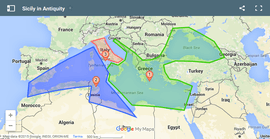
- Greeks
- Carthaginians (Phoenician, Punics)
- Romans
- Athens
- Carthage
- Rome
The ancient Greeks: the second superpower
The Greeks copied the Phoenicians by founding coastal colonies all over the Mediterranean from the 8th century B.C. onwards. We call them "colonies", but they had full political independence from the mother city. They were simply economic and military allies.
For 500 years, rivalry between the Greeks and the Carthaginians (blue area) was fierce. Piracy was the rule of the day. Attacking each other's trading stations to steal from the warehouses guaranteed rewards and honour at home for the winning captain-cum-thief. Athens, with her silver mines and highly skilled potters, was the greatest Greek trading city and Athenian coinage was trusted worldwide.
One Greek colony, Siracusa in Sicily, became so rich and powerful that Athens regarded it as a dangerous rival and tried (disastrously) to invade it! Siracusa's Greek theatre is still in such good contition that plays and concerts are performed there every summer. The Greek city of Agrigento on the south coast of Sicily is so vast and well-preserved that it outshines many cities in mainland Greece and is a UNESCO World Heritage Site.
The green area on the map above shows the region dominated by the Greeks when their expansion was at its largest.
The ancient Romans: the aggressive new upstarts
The Greeks and Phoenicians muddled alongside each other for five centuries of pirate raids.
From the 3rd century B.C. a third power made its presence felt. The Romans were a group of farmers from dangerous malarial swamps with no natural resources or crafts to trade, but outstanding military skills. They did not found city-states: they built an empire with a centralised government.
They beat the disjointed Greeks easily, picking them off one city-state at a time. They so admired the superiority of the Greek culture that they copied it - gods, arts, philosophy and all - and spread it wherever they conquered.
The Carthaginians were altogether harder to beat. They had seen their mother country in the Middle East destroyed once, so they knew the key to success was unity. The two powers were so closely matched that the Romans, after three "Punic Wars" which lasted centuries, only won by a whisker. The Carthaginians went down in Roman history as the most terrifying enemies on the planet. But for a few small twists of fate, we Europeans might all be speaking a Semitic language derived from Phoenician.
The Romans regarded Sicily as a backwater fit to be asset-stripped. They rebuilt some of the Greek and Phoenician cities they had ruined, and taxed the natives to the brink of starvation, generation after generation. One of the few Roman creations in Sicily which is truly spectacular is the Villa Romana del Casale with its famous bikini-girl mosaics in Piazza Armerina.
Ancient Sicily
Today, archaeologists have unearthed the legacy of these three super-powers all over the sunny island of Sicily.
We have dedicated a web page to each of these spectacular ancient beauty spots. It provides maps that show how to reach them by hire car, Trenitalia or coach, and of course the location of points of interest for your holidays in Sicily:
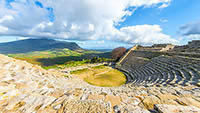
Segesta was right on the border between Carthaginian and Greek territory. As the map above shows, the Carthaginians held on to the western tip of Sicily for a long time, but eventually the Greeks had their day. There are large and very well-preserved Greek temples and one of the finest Greek theatres in Sicily... more
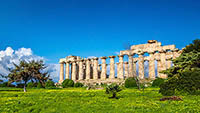
The city of Selinunte is only 40 km south of Segesta. It was founded by Greek colonists and later taken over by the Carthaginians. Today's archaeological site is 40 hectares and most of it is open to visitors... more
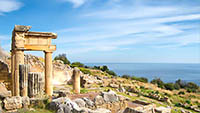
Solunto was originally a Carthaginian trading post, and then fell into Greek and Roman hands. It was abandoned by the Romans for reasons that are mysterious and was completely forgotten. If you are on holiday in Sicily, you have a unique opportunity: you can wander around inside the fully-preserved basic structure of this ancient small town... more
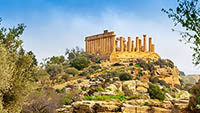
The Valley of the Temples is the most impressive archaeological site in Sicily. It was here that the ancient Greeks founded the city of Akragas. Since the Romans continued to use the Greek temples, they are remarkably well preserved. The preservation continues into the present day as UNESCO has declared the Valley of Temples a world heritage site... more
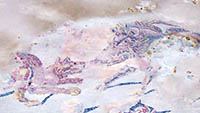
The Villa Romana del Casale is one of the few impressive Roman sites left to us. This villa was so impressive it was an official residence of a Roman emperor. The Villa Romana del Casale is especially well known today for its mosaics. The most famous of these shows with wonderful detail that the bikini was already in use in ancient times... more
Author
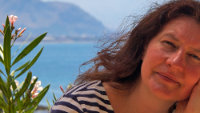
The information on this site comes from our Sicily expert Britta Bohn.
Britta has been dealing with daily life and life in Sicily for over 20 years.
Don't miss any of her tips! Subscribe to our free Newsletter:
An Invitation
Dear friends of Sicily, we invite you to join the Facebook Group "Trip-Tipp Sicily". Find answers to all your questions and discover exclusive tips for your trip to Sicily from those who have already made the journey and those who already know the island from the inside out:
The Essence of Sicily
